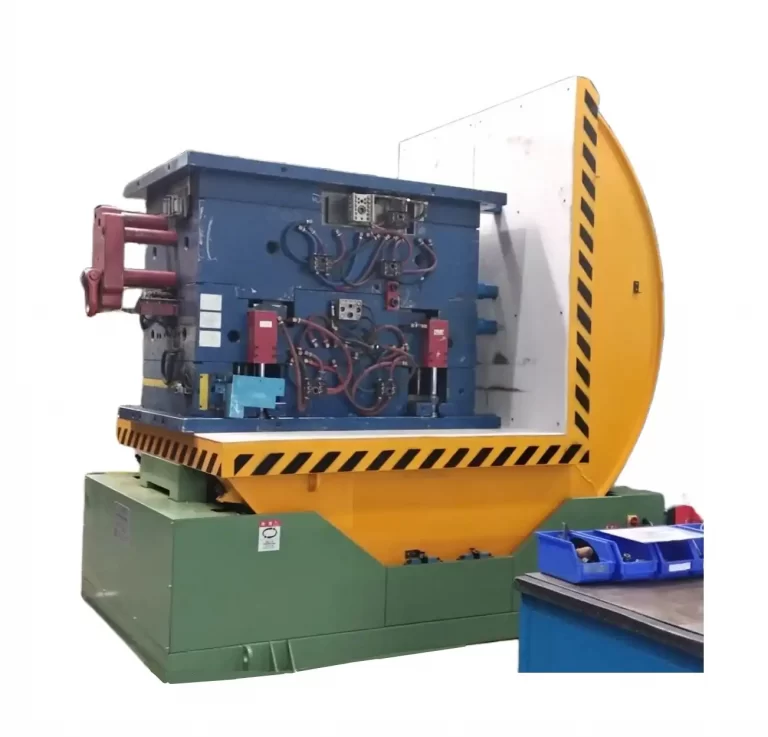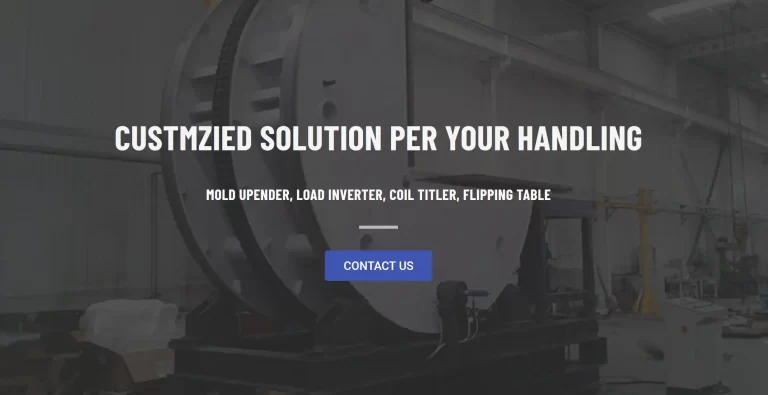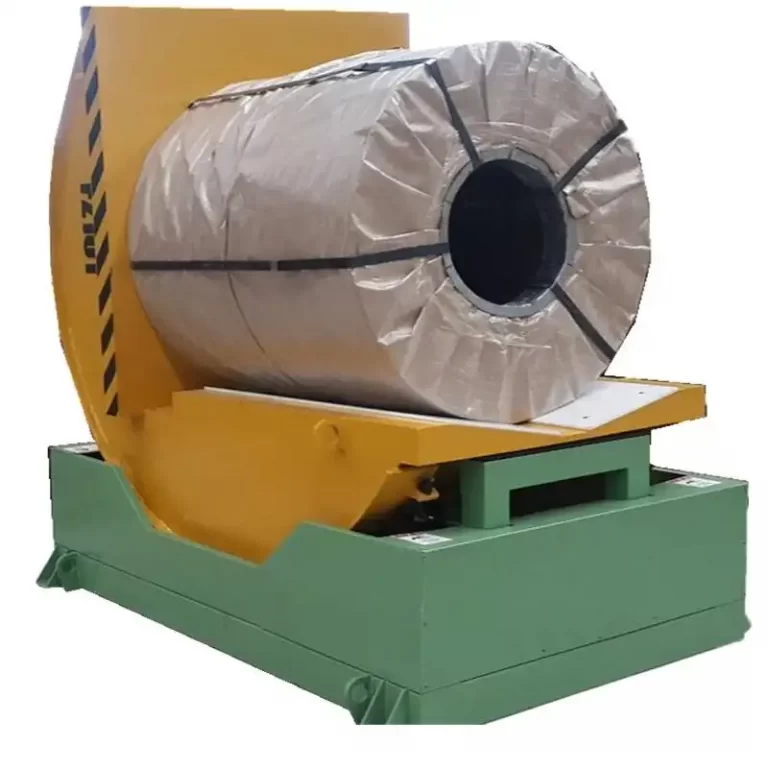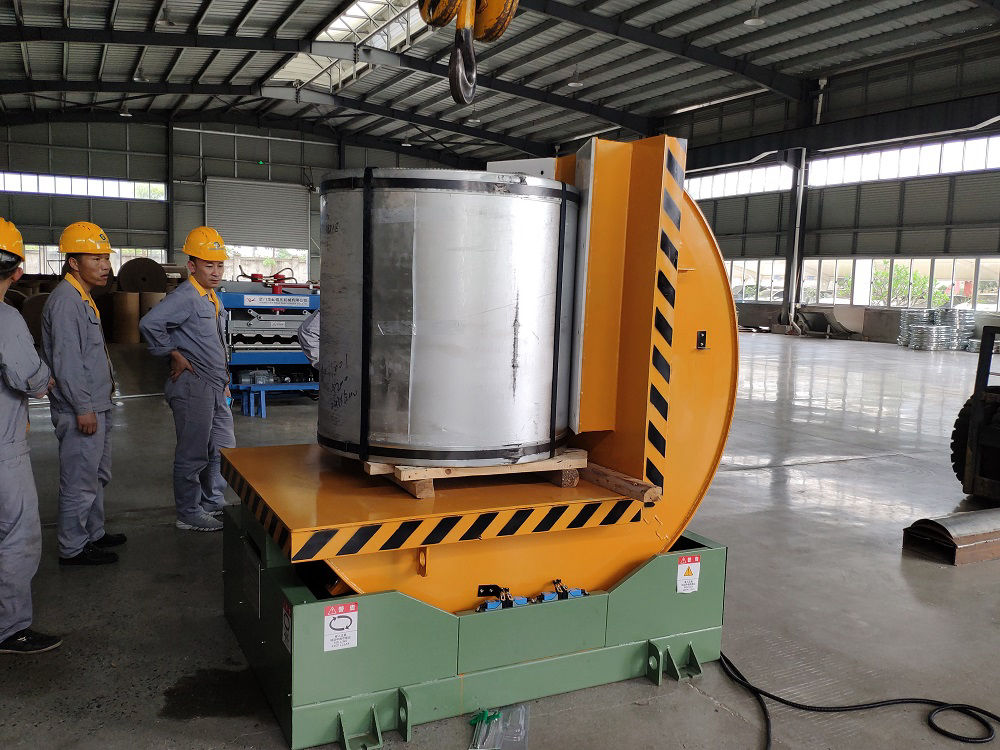How Do Coil Upenders Facilitate Just-in-Time Manufacturing Processes?
In today's fast-paced manufacturing landscape, efficiency and waste reduction are paramount. Just-in-time (JIT) manufacturing has emerged as a critical strategy for achieving these goals. But how do seemingly simple pieces of equipment like coil upenders fit into this sophisticated system? Understanding their role reveals a key aspect of streamlining material flow.

Coil upenders facilitate Just-in-Time manufacturing by ensuring materials are readily available at the point of use, precisely when needed. They streamline material flow by efficiently and safely rotating heavy coils, reducing handling time and minimizing work-in-progress inventory. This direct access to materials on demand is crucial for the responsiveness and efficiency of JIT systems.
This article delves into the essential role of coil upenders in optimizing JIT manufacturing processes. By examining their function and benefits, we will uncover how these often-overlooked tools are indispensable for companies striving for lean and efficient operations. Let's explore how coil upenders contribute to the core principles of JIT, from minimizing waste to maximizing inventory turnover.
Streamlining Material Flow with Coil Upenders in JIT Production
Just-in-time (JIT) manufacturing hinges on the principle of having materials arrive exactly when they are needed in the production process, eliminating unnecessary inventory and waste. Achieving this delicate balance requires precision and efficiency at every stage of material handling, especially when dealing with heavy and cumbersome items like coils.
Coil upenders are pivotal in JIT material flow because they provide a safe and efficient method to manipulate heavy coils, ensuring they are presented correctly at each stage of production, precisely when required. This eliminates delays, reduces manual handling, and optimizes workflow, all core tenets of JIT manufacturing.

To fully grasp the impact of coil upenders on JIT, let's delve deeper into their specific contributions and benefits within this lean manufacturing framework. We will explore how they enhance efficiency, reduce waste, and improve overall productivity, making them indispensable assets in JIT environments.
Enhancing JIT Efficiency: A Detailed Look at Coil Upender Benefits
Coil upenders are not merely material handling devices; they are strategic tools that significantly enhance the efficiency of JIT manufacturing. Their benefits are multifaceted and contribute directly to the core objectives of lean production. Let’s examine these advantages in detail:
| Benefit Category | Specific Advantage | Impact on JIT |
|---|---|---|
| Reduced Handling Time | Faster coil rotation and positioning | Minimizes delays in material flow, ensuring timely availability for production |
| Improved Safety | Eliminates manual lifting and awkward coil manipulation | Reduces risk of worker injury, contributing to a stable and reliable workforce |
| Minimized Space Usage | Vertical coil positioning | Frees up valuable floor space, aligning with JIT's space-saving goals |
| Reduced Damage | Controlled and precise coil movement | Protects coil integrity, reducing material waste and rework |
| Enhanced Workflow | Seamless integration into production lines | Streamlines operations, eliminating bottlenecks and improving throughput |
| Inventory Turnover | Faster material processing | Supports rapid inventory turnover, a key metric in JIT success |
Reduced Handling Time and Enhanced Workflow Synchronization: In JIT, time is of the essence. Coil upenders drastically reduce the time required to rotate and position heavy coils compared to manual methods or overhead cranes. This speed directly translates to faster material availability at each workstation, ensuring that production processes are not delayed due to material handling. The synchronized workflow, facilitated by coil upenders, ensures that materials move smoothly through the production line, just as they are needed, minimizing waiting times and maximizing throughput.
Improved Safety and Workforce Reliability: Manual handling of heavy coils poses significant safety risks, potentially leading to worker injuries and disruptions in production schedules. Coil upenders eliminate the need for manual lifting and awkward maneuvering, creating a safer working environment. A safer workplace contributes to a more reliable workforce, reducing absenteeism and ensuring consistent production output, crucial for meeting JIT demands.
Minimized Space Usage and Optimized Layout: JIT emphasizes efficient use of space to reduce storage costs and streamline operations. Coil upenders often allow for vertical positioning of coils, which significantly reduces the floor space required for material staging and handling. This space optimization is critical in JIT environments where minimizing footprint and maximizing production density are key objectives.
Reduced Material Damage and Waste Reduction: The controlled and precise movements of coil upenders minimize the risk of damage to coils during handling. Damage to raw materials directly contradicts JIT's principle of waste reduction. By protecting coil integrity, upenders ensure that materials are production-ready, reducing scrap, rework, and material loss, all of which contribute to a more efficient and cost-effective JIT system.
Support for Rapid Inventory Turnover: JIT systems thrive on rapid inventory turnover, meaning materials are processed quickly and efficiently. Coil upenders, by speeding up material handling and reducing processing times, directly support this principle. Faster material throughput ensures that inventory moves quickly through the production cycle, minimizing the amount of capital tied up in work-in-progress inventory and maximizing the efficiency of the entire JIT system.
Minimizing Work-in-Progress Inventory with Efficient Coil Handling
One of the core tenets of Just-in-Time manufacturing is the minimization of work-in-progress (WIP) inventory. Excessive WIP ties up capital, consumes valuable space, and can obscure inefficiencies within the production process. Coil upenders play a crucial role in reducing WIP by ensuring a smooth and demand-driven flow of materials.
Coil upenders directly minimize work-in-progress inventory in JIT systems by facilitating the immediate processing of coils upon arrival. Their efficient handling capabilities prevent coils from becoming stagnant WIP, ensuring materials move swiftly from receiving to production, aligning perfectly with JIT principles.

Let's explore how coil upenders contribute to this reduction in WIP and how this directly benefits companies implementing JIT methodologies. We will examine specific mechanisms and operational benefits that underscore the value of coil upenders in achieving lean inventory goals.
Coil Upenders: Key Mechanisms for WIP Reduction in JIT
The ability of coil upenders to minimize WIP in JIT environments stems from several key operational mechanisms. These mechanisms directly address the common causes of WIP buildup and contribute to a leaner, more responsive production system.
- On-Demand Material Presentation: Coil upenders ensure that coils are ready for processing precisely when needed. This eliminates the need to stage coils in advance, preventing the accumulation of WIP waiting for the next production step.
- Reduced Bottlenecks: By speeding up coil handling, upenders prevent material handling from becoming a bottleneck in the production line. This smooth material flow minimizes delays and reduces the buildup of WIP between workstations.
- Faster Throughput Times: Efficient coil handling directly contributes to faster overall throughput times. Reduced handling time means coils move through the production process more quickly, minimizing the duration they spend as WIP.
- Improved Production Line Balance: Coil upenders help balance the production line by ensuring a consistent and reliable supply of materials. This balanced flow prevents some workstations from being idle while others are overloaded with WIP.
- Enhanced Responsiveness to Demand: With minimized WIP, JIT systems become more responsive to changes in customer demand. Coil upenders contribute to this agility by enabling quick adjustments in material flow and production schedules without being hindered by large WIP buffers.
By implementing coil upenders, manufacturers can create a pull system where materials are processed and moved through the production line based on actual demand, rather than being pushed into the system based on forecasts. This demand-driven approach, facilitated by efficient coil handling, is the cornerstone of WIP reduction in JIT manufacturing.
Integrating Coil Upenders for Seamless Workflow Synchronization
Just-in-time manufacturing is not just about inventory reduction; it's about creating a synchronized workflow where every step of the production process is seamlessly integrated. Coil upenders, when strategically implemented, act as vital links in this chain, ensuring smooth material flow and operational harmony.

Coil upenders are crucial for workflow synchronization in JIT because they ensure materials are delivered to the right place at the right time, in the correct orientation. This precise material presentation eliminates disruptions, prevents bottlenecks, and allows for a continuous and synchronized production flow, fundamental to JIT success.
Let's examine the practical steps and considerations for integrating coil upenders into JIT workflows to achieve optimal synchronization and efficiency. We will discuss layout design, system integration, and operational best practices to maximize the benefits of coil upenders in a synchronized JIT environment.
Achieving Workflow Harmony: Best Practices for Coil Upender Integration
To effectively integrate coil upenders into JIT workflows and achieve seamless synchronization, manufacturers should consider these best practices:
- Strategic Layout Design: Position coil upenders strategically within the production layout to minimize material travel distances and ensure smooth flow between workstations. Consider proximity to processing equipment and optimize for efficient material handover.
- System Integration: Integrate coil upenders with existing material handling systems and production line controls. Automated systems can further enhance synchronization by coordinating upender operation with overall production schedules.
- Standardized Operating Procedures: Develop clear and standardized operating procedures for coil upender usage. This ensures consistent and efficient operation, minimizes errors, and maximizes safety.
- Preventive Maintenance: Implement a robust preventive maintenance program for coil upenders to ensure their reliability and uptime. Regular maintenance prevents breakdowns that can disrupt the synchronized workflow.
- Operator Training: Provide comprehensive training to operators on the safe and efficient operation of coil upenders. Well-trained operators are crucial for maximizing the benefits of these tools and maintaining workflow synchronization.
- Real-time Monitoring: Utilize sensors and monitoring systems to track coil upender performance and material flow in real-time. This data provides insights for continuous improvement and helps identify potential synchronization issues proactively.
- Supplier Collaboration: Extend workflow synchronization principles to suppliers. Collaborate with suppliers to ensure timely and sequenced delivery of coils, further enhancing the JIT material flow.
By adopting these best practices, manufacturers can seamlessly integrate coil upenders into their JIT workflows, creating a truly synchronized and efficient production system. This harmony not only reduces waste and inventory but also enhances responsiveness, flexibility, and overall operational excellence.
Conclusion
Coil upenders, while seemingly simple pieces of machinery, are indispensable tools in facilitating Just-in-Time manufacturing processes. Their ability to streamline material flow, minimize work-in-progress inventory, and enable seamless workflow synchronization directly contributes to the core principles of JIT. By efficiently and safely handling heavy coils, coil upenders empower manufacturers to achieve leaner operations, reduce waste, and enhance responsiveness, all essential for thriving in today's competitive landscape. Embracing coil upender technology is a strategic step towards realizing the full potential of JIT and achieving manufacturing excellence through optimized material handling.



